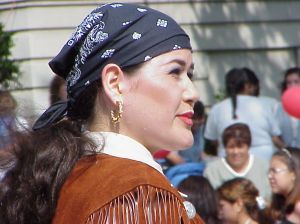2008 Presidential Election Voter Turnout Increases by 5MM
Data Show Significant Increases Among Hispanic, Black and Young Voters
About 131 million people reported voting in the 2008 U.S. presidential election, an increase of 5 million from 2004, according to a new table package released today by the U.S. Census Bureau. The increase included about 2 million more black voters, 2 million more Hispanic voters and about 600,000 more Asian voters, while the number of non-Hispanic white voters remained statistically unchanged.
Additionally, voters 18 to 24 were the only age group to show a statistically significant increase in turnout, reaching 49 percent in 2008 compared with 47 percent in 2004. Blacks had the highest turnout rate among 18- to 24-year-old voters — 55 percent, an 8 percent increase from 2004. The increased turnout among certain demographic groups was offset by stagnant or decreased turnout among other groups, causing overall 2008 voter turnout to remain statistically unchanged — at 64 percent — from 2004.
“The 2008 presidential election saw a significant increase in voter turnout among young people, blacks and Hispanics,” said Thom File, a voting analyst with the Census Bureau’s Housing and Household Economic Statistics Division. “But as turnout among some other demographic groups either decreased or remained unchanged, the overall 2008 voter turnout rate was not statistically different from 2004.”
The table package released today, Voting and Registration in the Election of 2008,examines the levels of voting and registration in the November 2008 presidential election, the demographic characteristics of citizens who reported that they were registered for or voted in the election, and the reasons why registered voters did not vote.
Although the youngest voters were the only age group to show a statistically significant increase in turnout, voting did tend to increase with age. In 2008, younger citizens (18-24) had the lowest voting rate (49 percent), while citizens who fell into older age groups (45-64 and 65-plus) had the highest voting rates (69 percent and 70 percent, respectively).
Looking at voter turnout by race and Hispanic origin, non-Hispanic whites (66 percent) and blacks (65 percent) had the highest levels in the November 2008 election. Voting rates for Asians and Hispanics were not statistically different from one another at about 49 percent.
Relative to the presidential election of 2004, the voting rates for blacks, Asians and Hispanics each increased by about 4 percentage points. The voting rate for non-Hispanic whites decreased by 1 percentage point.
The voting rate was highest in the Midwest (66 percent), while the rates in the West, Northeast and South were about 63 percent each.
Among states, voting rates varied widely. Among states and state-equivalents with the highest voter turnout were Minnesota and the District of Columbia, each with voting rates of about 75 percent. Hawaii and Utah were among the states with the lowest turnouts, each with approximately 52 percent.
By sex, women had a higher voting rate (66 percent) than males (62 percent). Neither was statistically different from 2004.
The overall voting age (18 and older) citizen population in the United States in 2008 was
206 million compared with 197 million in 2004. Of that total, 146 million, or 71 percent, reported being registered to vote. That’s slightly lower than the 72 percent who reported being registered to vote in the 2004 presidential election, but does represent an increase of approximately 4 million registered voters. The percentage of those registered to vote that actually did so was slightly higher in the 2008 election (90 percent) than in 2004 (89 percent).
Editor’s note: The information can be accessed at http://www.census.gov/population/nas/content/live/hispanic/socdemo/voting.html.
.These data come from the Current Population Survey. Statistics from sample surveys are subject to sampling and nonsampling error. For further information on the source of the data and accuracy of the estimates, including standard errors and confidence intervals, go to Attachment 16 of
http://www.census.gov/apsd/techdoc/cps/cpsnov08.pdf.
Source: U.S. Census Bureau








Leave a Reply
Want to join the discussion?Feel free to contribute!